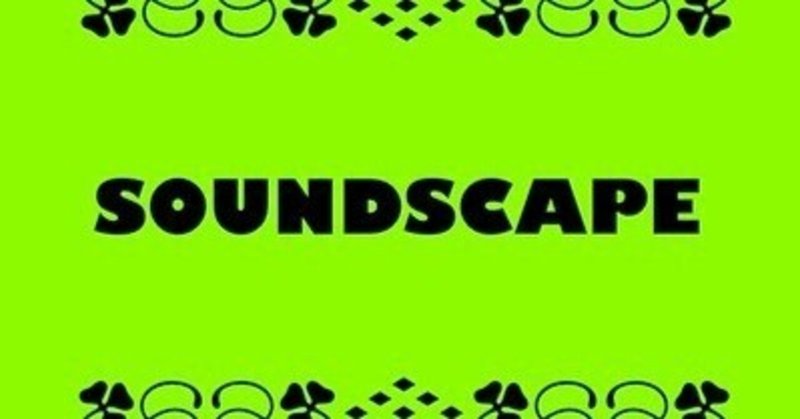
英語教育・英語学習に関する独り言40 ー 模擬TOEFL問題作成について16
IELTSを作れと言われているのに、ついつい TOEFL を作ってしまう。まあ、正式にそのお達しが出たわけではないので、もうしばらく趣味の世界に浸っていてもいいのだろう。今回はマリー・シェーファーのサウンドスケープ理論を題材にした。これは ICU の general education の一環で、2年生の一学期に履修した。たしか伊藤先生の音楽学概論だった。同じ講座の中でジョン・ケージの『4分33秒』にも触れたっけ。懐かしい。Without further ado, enjoy!
Question 01
According to the lecture, what is a soundscape?
(A) An environment made up by natural and artificial sounds
(B) A combination of human-made sounds and natural landscapes
(C) A realm of carefully crafted musical components
(D) A sphere of sounds of natural origin
Question 02
According to the lecture, what did Schafer encourage people to do?
(A) To pay more attention to his hypothesis
(B) To become able to play musical instruments
(C) To consciously listen to the surroundings
(D) To better address the problem of noise pollution
Question 03
What is one example of soundscape design for urban areas?
(A) Sound parks
(B) Sound schools
(C) Sound-proof hospitals
(D) Sound-proof offices
Question 04
What makes modern libraries different from traditional libraries?
(A) Modern libraries install bookshelves that absorb noises.
(B) Modern libraries play synthetic background music.
(C) Modern libraries are more suitable for studying alone.
(D) Modern libraries are intended to architecturally control noise levels.
Question 05
How has soundscape theory changed our view?
(A) We have become more aware of the need to eliminate all human-made sounds.
(B) We now prioritize the design of silent spaces over functional acoustics.
(C) We have come to think more acoustically about the environment.
(D) We now consider sound to be a less important factor in our built environments.
オーディオ・スクリプト
Listen to part of a lecture in an architecture class
Professor: Today, we'll be discussing the influential work of Canadian composer and theorist Raymond Murray Schafer, and his groundbreaking contributions to the field of soundscape studies. Now, what is a soundscape? Well, a soundscape refers to the sphere of everyday sounds, both natural and human-made, that comprise a particular acoustic environment.
Schafer was one of the first scholars to seriously consider the soundscape as an important part of both our physical and cultural surroundings. He encouraged people to pay closer attention to the noises around them, from birdsong to traffic, and to appreciate how these sounds shape our perception of different spaces.
Schafer first advocated the concept of soundscape. Then, he applied it to practical uses, including urban planning, architecture, and environmental protection. One of his key insights was the concept of "soundscape design" for cities. This involves integrating acoustic considerations into the overall planning and design of urban areas, ensuring that the auditory environment is optimized to enhance the quality of life for residents.
For example, Schafer's work has led to the creation of "sound parks" within cities. These spaces feature strategically placed vegetation and topography that not only look appealing, but also function as natural sound buffers. This helps shield visitors from disruptive noises and foster a more serene and contemplative atmosphere.
Schafer's influence can also be seen in the redesign of public transportation hubs, like metro stations. Architects and engineers now work to mitigate echoes and reverberations, using materials that absorb sound and create a more harmonious auditory environment. In some cases, they even incorporate culturally relevant music to enhance the overall experience for commuters.
Another area where Schafer's ideas have had a major impact is in the design of public buildings, such as modern libraries. Traditionally, libraries have been thought of as quiet places. However, they are actually spaces where soundscape design becomes most practical. Why? Well, libraries do incorporate sound-absorbing materials like carpeting, fabric wall panels, and strategically placed bookshelves with the aim of mitigating echoes and reverberations. This helps to control noise levels and prevent distracting sounds from carrying throughout the library. Some libraries might even introduce specific, low-level sounds as part of the soundscape. This could include calming natural sounds like the sound of flowing water or gentle music. Studies have shown that these types of sounds can actually improve concentration and reduce stress. So, this way, they successfully create a more pleasant atmosphere for library users. Soundscapes are now meticulously curated in these spaces, with different zones tailored to specific acoustic requirements. There might be vibrant, interactive areas for group work, alongside quiet reading nooks where pin-drop silence is maintained.
Schaeffer's influence has even extended to the healthcare sector. The concept of the healing soundscape has gained prominence, with architects and professionals collaborating to design hospital environments that incorporate natural sounds like flowing water and bird songs to promote patient comfort and recovery.
Beyond public spaces, Schafer's ideas have also influenced contemporary residential architecture. Architects now strive to optimize the auditory environment within homes, carefully considering factors like window and door placement, as well as the use of sound-absorbing materials, to create peaceful, harmonious soundscapes.
Since the invention of the concept, Raymond Murray Schafer's groundbreaking work on soundscape theory has had a profound impact on the way we plan, design, and experience our built environments. By highlighting the importance of the acoustic dimension, Schafer has helped shift the way we think about the role of sound in shaping our daily lives and overall well-being. To further illustrate how Schafer's soundscape theory has influenced urban design, let me show you several slides of major cities in Europe that exemplify these principles. Take a close look, because your homework for next week will be to research a local park or building through the lens of soundscape theory.
正答
Question 01 (C)
Question 02 (C)
Question 03 (A)
Question 04 (D)
Question 05 (C)
この記事が気に入ったらサポートをしてみませんか?
